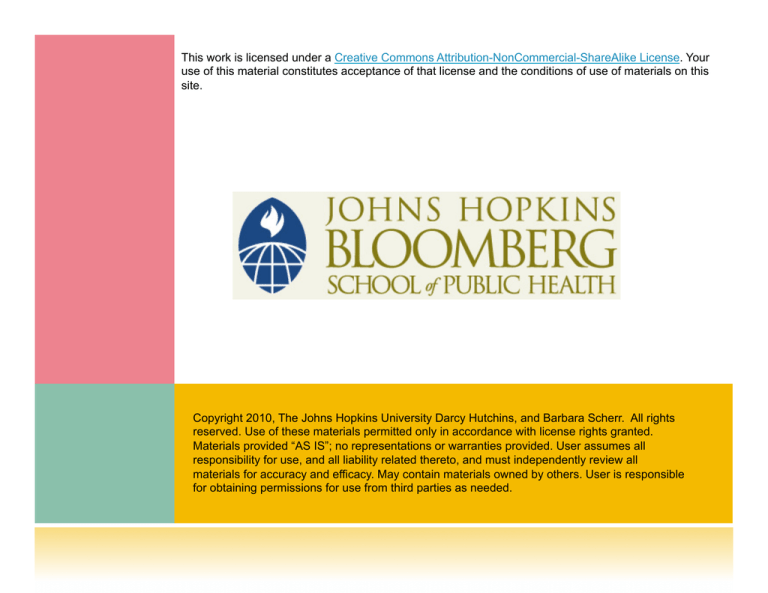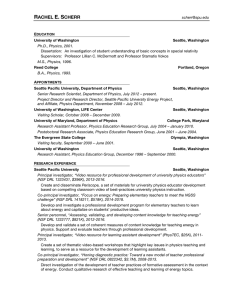
This work is licensed under a Creative Commons Attribution-NonCommercial-ShareAlike License. Your
use of this material constitutes acceptance of that license and the conditions of use of materials on this
site.
Copyright 2010, The Johns Hopkins University Darcy Hutchins, and Barbara Scherr. All rights
reserved. Use of these materials permitted only in accordance with license rights granted.
Materials provided “AS IS”; no representations or warranties provided. User assumes all
responsibility for use, and all liability related thereto, and must independently review all
materials for accuracy and efficacy. May contain materials owned by others. User is responsible
for obtaining permissions for use from third parties as needed.
G OAL -O RIENTED
P ARTNERSHIP P ROGRAMS
FOR S TUDENT S UCCESS
May 14, 2010 Johns Hopkins School of Public Health Facilitators Darcy Hutchins and Barbara Scherr I NTRODUCTIONS
QuesBons:
What is your name?
What program are you in and how long have you been in that program?
How is this topic relevant to your long-­‐
term goals? A B LAST F ROM T HE P AST
W A R M -U P A C T I V I T Y
S ESSION O BJECTIVES
ParBcipants will:
Understand the components of a comprehensive school-­‐family-­‐community partnership program.
Understand Maryland’s school and student demographics
Learn about exemplary programs and strategies to engage parents
Brainstorm ideas for schools to implement that support any/all of the 7 components of coordinated school health to promote healthy student behavior and student achievement. R ESEARCH SHOWS THAT
Students with involved parents, no maRer what their income or background, are more likely to do beRer in school, stay in school longer, and like school more.
Partnership programs can increase student achievement, aRendance, improve behavior, and promote beRer social skills.
When partnership pracBces are carefully linked to school goals, they involve families in ways that directly assist students’ learning and success. R ESEARCH ALSO SHOWS THAT
Teachers and administrators are iniBally resistant to increasing family involvement.
Teachers and administrators need inservice, preservice, and advanced educaBon on partnerships.
Schools must reach out in order to involve all families.
Teachers who use pracBces of partnership are more likely to report that all parents can help their children.
Programs will be most useful to schools and to families if they are customized, comprehensive, and conBnually improved to help meet important goals for students. T AKE
A LOOK AT
M ARYLAND
MD public schools -­‐ 1459
848,412 students
45.5% or 385,782 Caucasians
37.9% or 321,650 African-­‐Americans
10% or 85, 153 Hispanic
6.1% or 52,156 Asian/Pacific Islander
0.4% or 3,671 American Indian/Alaskan NaLve Maryland Public School Enrollment by Race/Ethnicity and Gender and Number of Schools September 30, 2009, MSDE-­‐DAA 02/10 T OP 5 LANGUAGES :
SY 2008-2009
Español Spanish
中国人
Français Chinese 한국 Korean
việt Vietnamese French M ARYLAND S TUDENTS
SY 2008-09
Number of students on IEPs • Total enrollment • Special Ed Students • Percent 841,671 110,671 13.1% Maryland Special EducaLon/Early IntervenLon Services Census Data & Related Tables , October 31, 2008
Number of Suspensions 153,110 (includes a[endance, dangerous substances, weapons, a[acks/ threats/
fighLng, arson/fire/explosives, sex offenses, disrespect/ insubordinaLon, other)
Number of Students Suspended • Total • Special Ed Students 75,544 14,685 Maryland Public School Suspensions by School and Major Offense Category, Combined In-­‐School and Out-­‐of School Suspensions, 2008-­‐2009 H EALTH R ELATED E XCLUSIONS
SY 2008-2009
School Year 2008-­‐09
ImmunizaLons -­‐ 179 •
Personal Health – 1,158 Maryland Public School Suspensions by School and Major Offense Category, Combined In-­‐School and Out-­‐ of-­‐School Suspensions, 2008-­‐2009
Theoretical Model
OVERLAPPING SPHERES OF INFLUENCE OF FAMILY, SCHOOL, AND
COMMUNITY ON CHILDREN’S LEARNING
Force C
Experience,
Philosophy,
Practices
of School
Force B
Experience,
Philosophy,
Practices
of Family
Force D
Experience,
Philosophy,
Practices
of Community
Force A
Time/Age/Grade Level
THE KEYS TO SUCCESSFUL
SCHOOL-FAMILY-COMMUNITY PARTNERSHIPS
EPSTEIN’S SIX TYPES OF INVOLVEMENT
Type 1
PARENTING: Assist families with parenting and child-rearing
skills, understanding child and adolescent development, and setting
home conditions that support children as students at each age and
grade level. Assist schools in understanding families.
Type 2
COMMUNICATING: Communicate with families about school
programs and student progress through effective school-to-home
and home-to-school communications.
Type 3
VOLUNTEERING: Improve recruitment, training, work, and
schedules to involve families as volunteers and audiences at school
or in other locations to support students and school programs.
Type 4
LEARNING AT HOME: Involve families with their children in
learning activities at home, including homework and other
curriculum-related activities and decisions
Type 5
Type 6
DECISION MAKING: Include families as participants in school
decisions, governance, and advocacy through PTA/PTO, school
councils, committees, action teams, and other parent organizations.
COLLABORATING WITH COMMUNITY: Coordinate resources
and services for students, families, and the school with businesses,
agencies, and other groups, and provide services to the community.
TYPE 1
PARENTING
BASIC RESPONSIBILITIES
OF
FAMILIES
Housing, health, nutriBon, clothing, safety
ParenBng skills for all age levels
Home condiBons that support children as students at all grade levels
InformaBon and acBviBes to help schools understand children and families TYPE 2
COMMUNITCATING
BASIC RESPONSIBILITIES
OF
SCHOOLS
SCHOOL-­‐TO-­‐HOME
Memos, noBces, report cards, conferences, newsleRers, phone calls, computerized messages, e-­‐mail, websites HOME-­‐TO-­‐SCHOOL
Two-­‐way channels of communicaBon for quesBons and interacBons TYPE 3
VOLUNTEERING
VOLUNTEERS
In school or classroom
For school or classroom AUDIENCES
ARend assemblies, performances, sports events, recogniBon, and award ceremonies, celebraBons, and other events H OW HAVE YOU SEEN
T YPES 1-3 IN ACTION ?
Paren*ng Communica*ng Volunteering TYPE 4
LEARNING AT HOME
INVOLVEMENT
IN
ACADEMIC ACTIVITIES
INFORMATION FOR FAMILIES ON…
How to help at home with homework
Required skills to pass each subject
Curriculum-­‐related decisions
Other skills and talents TYPE 5
DECISION MAKING
PARTICIPATION
AND
LEADERSHIP
Advisory groups
School-­‐Based Management Team
AcBon Team for Partnerships
PTA/PTO
Other school or district commiRees
Independent school advisory groups TYPE 6
COLLABORATING WITH THE
COMMUNITY
Community contributes to the school, students, and families:
Business partners Cultural and recreaBonal groups Health services Service and volunteer groups Senior ciBzen organizaBons Faith organizaBons Government and military agencies Other groups and programs School, students, and families contribute to the community Goal-Oriented Partnership Program
School-Based Management Team
School Improvement Plan
ACTION TEAM for SCHOOL,
FAMILY, and COMMUNITY
PARTNERSHIPS
Academic
Goal 1
Academic
Goal 2
Non-Academic
Goal 3
Partnership
Goal 4
Draw from the
six types of
involvement to
meet this goal.
Draw from the
six types of
involvement to
meet this goal.
Draw from the
six types of
involvement to
meet this goal.
Draw from the
six types of
involvement to
meet this goal.
Reprinted with permission: Epstein, J. L., Sanders, M. G., Simon, B. S., Salinas, K. C., Jansorn, N. R., & Van Voorhis, F. L. (2002). School, Family, and Community Partnerships: Your Handbook for Action (Second Edition).
Thousand Oaks, CA: Corwin Press.
C OORDINATED S CHOOL H EALTH
P ROGRAM
S TRATEGIES
THAT SUPPORT
COORDINATED SCHOOL HEALTH
P ARTNERSHIP P RACTICES
THAT
SUPPORT AND PROMOTE SCHOOL
HEALTH
Read your assigned Component Be prepared to: 1. briefly discuss the component for the group. 2. brainstorm a strategy that could be implemented to promote healthy student behavior and academic success. 3. idenBfy partners that can support strategy. 4. describe how this strategy could be used in your future work. Q UESTIONS & A NSWERS
How does the family and community component fit with the other components taught in this course?
What quesBons do you sBll have about school, family, and community partnership programs? C ONTACT I NFORMATION
Darcy Hutchins Barbara Scherr Senior Program Facilitator Family Involvement Coordinator Johns Hopkins University Maryland State Department of EducaBon 410-­‐516-­‐8893 410-­‐767-­‐0291 dhutchins@csos.jhu.edu bscherr@msde.state.md.us www.partnershipschools.org www.marylandpublicschools.org



